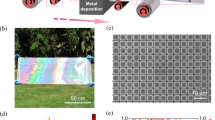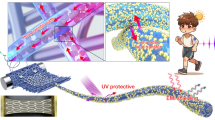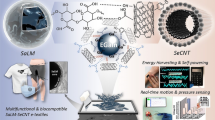Abstract
We report a highly band-selective, bifunctional meta-surface that serves as an ultra-wide perfect absorber for near-infrared (NIR) band and a visible-band sensor, based on a rational design strategy involving stacking and/or grating of metals, inorganic insulators, and stimuli-responsive materials. PNIPAAm-based hydrogel was utilized as a layer of stimuli-responsive insulator, which is allowed to reversibly swell and collapse in one dimension in response to stimuli such as ambient temperature and chemical environment to empower the sensing capability in the visible band, with the perfect absorption in NIR region intact. The average absorption reached an impressive 99.4% from 780 to 2500 nm, which is attributed to the synergy of localized surface plasmon (LSP), propagating surface plasmon (PSP), and cavity mode. The reported bi-functional meta-surface is particularly attractive for band-selective solar energy harvesting, naked-eye sensing, and adaptive imaging.
Similar content being viewed by others
References
Lu L, Joannopoulos J D, Soljačić M. Topological photonics. Nat Photon, 2014, 8: 821–829
Lu Y, Zhu Y, Chen Y, et al. Optical properties of an ionic-type phononic crystal. Science, 1999, 284: 1822–1824
Jahani S, Jacob Z. All-dielectric metamaterials. Nat Nanotech, 2016, 11: 23–36
Kildishev A V, Boltasseva A, Shalaev V M. Planar photonics with metasurfaces. Science, 2013, 339: 1232009
High A A, Devlin R C, Dibos A, et al. Visible-frequency hyperbolic metasurface. Nature, 2015, 522: 192–196
Guo C F, Sun T, Cao F, et al. Metallic nanostructures for light trapping in energy-harvesting devices. Light Sci Appl, 2014, 3: e161
Watts C M, Liu X L, Padilla W J. Metamaterial electromagnetic wave absorbers. Adv Mater, 2012, 24: OP98–OP120
Pendry J B, Schurig D, Smith D R. Controlling electromagnetic fields. Science, 2006, 312: 1780–1782
Liu R P, Zhao Z Y, Ji C L, et al. Metamaterials beyond negative refractive index: Applications in telecommunication and sensing. Sci China Tech Sci, 2016, 59: 1007–1011
Rechtsman M C, Zeuner J M, Plotnik Y, et al. Photonic floquet topological insulators. Nature, 2013, 496: 196–200
He C, Chen X L, Lu M H, et al. Tunable one-way cross-waveguide splitter based on gyromagnetic photonic crystal. Appl Phys Lett, 2010, 96: 121133
Wang W, Zhao Z, Zou Q, et al. Self-adaptive radiative cooling and solar heating based on a compound metasurface. J Mater Chem C, 2020, 8: 3192–3199
Fang Y, Hou Y B, Lou Z D, et al. Surface plasmonic effect and scattering effect of au nanorods on the performance of polymer bulk heterojunction solar cells. Sci China Tech Sci, 2013, 56: 1865–1869
Zhang P, Biligetu P, Qi D X, et al. Mechanical design and energy absorption of 3d novel hybrid lattice metamaterials. Sci China Tech Sci, 2021, 64: 2220–2228
Luo Y, Ying X, Pu Y, et al. Infrared metasurface made of composite right-left handed transmission-line. Appl Phys Lett, 2016, 108: 231103
Laroche M, Carminati R, Greffet J J. Near-field thermophotovoltaic energy conversion. J Appl Phys, 2006, 100: 77
Chen W, Liu J, Ma W Z, et al. Numerical study of multilayer planar film structures for ideal absorption in the entire solar spectrum. Appl Sci, 2020, 10: 3276
Lin C H, Chern R L, Lin H Y. Polarization-independent broad-band nearly perfect absorbers in the visible regime. Opt Express, 2011, 19: 415–424
Lee J, Lim S. Bandwidth-enhanced and polarisation-insensitive metamaterial absorber using double resonance. Electron Lett, 2011, 47: 8–9
Wu D, Liu Y, Xu Z, et al. Numerical study of the wide-angle polarization-independent ultra-broadband efficient selective solar absorber in the entire solar spectrum (solar RRL 7/2017). Sol RRL, 2017, 1: 1770126
Nguyen D M, Lee D, Rho J. Control of light absorbance using plasmonic grating based perfect absorber at visible and near-infrared wavelengths. Sci Rep, 2017, 7: 2611
Li Y, Liu Z, Zhang H, et al. Ultra-broadband perfect absorber utilizing refractory materials in metal-insulator composite multilayer stacks. Opt Express, 2019, 27: 11809–11818
Cai H, Sun Y, Wang X, et al. Design of an ultra-broadband near-perfect bilayer grating metamaterial absorber based on genetic algorithm. Opt Express, 2020, 28: 15347–15359
Yu Z Y, Xu F, Lin X W, et al. Tunable broadband isolator based on electro-optically induced linear gratings in a nonlinear photonic crystal. Opt Lett, 2010, 35: 3327–3329
Qian X, Wu H, Wang Q, et al. Electro-optic tunable optical isolator in periodically poled LiNbO3. J Appl Phys, 2011, 109: 053111
Tam R Y, Smith L J, Shoichet M S. Engineering cellular microenvironments with photo- and enzymatically responsive hydrogels: Toward biomimetic 3D cell culture models. Acc Chem Res, 2017, 50: 703–713
Ahmed E M. Hydrogel: Preparation, characterization, and applications: A review. J Adv Res, 2015, 6: 105–121
Gil E, Hudson S. Stimuli-reponsive polymers and their bioconjugates. Prog Polym Sci, 2004, 29: 1173–1222
Qin M, Sun M, Hua M, et al. Bioinspired structural color sensors based on responsive soft materials. Curr Opin Solid State Mater Sci, 2019, 23: 13–27
Ehrenhofer A, Wallmersperger T. A normalization concept for smart material actuation by the example of hydrogels. Proc Appl Math Mech, 2018, 18: e201800176
Gisbert Quilis N, van Dongen M, Venugopalan P, et al. Actively tunable collective localized surface plasmons by responsive hydrogel membrane. Adv Opt Mater, 2019, 7: 1900342
Chen Y. Nanofabrication by electron beam lithography and its applications: A review. MicroElectron Eng, 2015, 135: 57–72
Campo A, Greiner C. Su-8: A photoresist for high-aspect-ratio and 3d submicron lithography. J Micromech Microeng, 2007, 17: R81–R95
Han W H, Wang Y Z, Su J M, et al. Fabrication of nanofibrous sensors by electrospinning. Sci China Tech Sci, 2019, 62: 886–894
Palik E D. Handbook of Optical Constants of Solids. American: Academic Press, 1998
Toma M, Jonas U, Mateescu A, et al. Active control of spr by thermoresponsive hydrogels for biosensor applications. J Phys Chem C, 2013, 117: 11705–11712
Sai H, Kanamori Y, Yugami H. Tuning of the thermal radiation spectrum in the near-infrared region by metallic surface microstructures. J Micromech Microeng, 2005, 15: S243–S249
Liu J, Ma W Z, Chen W, et al. Numerical analysis of an ultra-wideband metamaterial absorber with high absorptivity from visible light to near-infrared. Opt Express, 2020, 28: 23748–23760
Lei L, Li S, Huang H, et al. Ultra-broadband absorber from visible to near-infrared using plasmonic metamaterial. Opt Express, 2018, 26: 5686–5693
Ding F, Dai J, Chen Y, et al. Broadband near-infrared metamaterial absorbers utilizing highly lossy metals. Sci Rep, 2016, 6: 39445
Wang H, Wang L. Perfect selective metamaterial solar absorbers. Opt Express, 2013, 21: A1078
Yang J, Sauvan C, Jouanin A, et al. Ultrasmall metal-insulator-metal nanoresonators: Impact of slow-wave effects on the quality factor. Opt Express, 2012, 20: 16880–16891
Brasse Y, Müller M B, Karg M, et al. Magnetic and electric resonances in particle-to-film-coupled functional nanostructures. ACS Appl Mater Interfaces, 2018, 10: 3133–3141
Sharma N, Keshmiri H, Zhou X, et al. Tunable plasmonic nanohole arrays actuated by a thermoresponsive hydrogel cushion. J Phys Chem C, 2016, 120: 561–568
Kawa T, Numata G, Lee H, et al. Temperature sensing based on multimodal interference in plastic optical fibers: Sensitivity enhancement by annealing. In: Proceedings of the Conference on Lasers and Electro-Optics Pacific Rim (CLEO-PR), 2017. s1486
Qin M, Sun M, Bai R, et al. Bioinspired hydrogel interferometer for adaptive coloration and chemical sensing. Adv Mater, 2018, 30: e1800468
Clare T L. Hydrogel sensors for detection of metal ions. US Patent, 2020019175A1, 2020-06-18
Author information
Authors and Affiliations
Corresponding author
Additional information
This work was supported by the Natural Science Foundation of Shanghai (Grant No. 20ZR1471700), the Oceanic Interdisciplinary Program of Shanghai Jiao Tong University (Grant No. SL2020MS009), and the Prospective Research Program at Shanghai Jiao Tong University (Grant No. 19X160010008). Xiaoshi Qian thanks the student innovation center at Shanghai Jiao Tong University for the support of computational facility.
Rights and permissions
About this article
Cite this article
Lei, Z., Qian, X., Jiang, K. et al. Highly band-selective meta-surfaces exhibiting perfect near infrared absorption and concurrent visible band sensing: A numerical study. Sci. China Technol. Sci. 65, 809–816 (2022). https://doi.org/10.1007/s11431-021-1982-y
Received:
Accepted:
Published:
Issue Date:
DOI: https://doi.org/10.1007/s11431-021-1982-y




